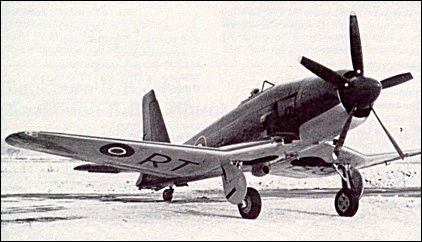|
| The first prototype flew on April 1, 1947.
 | A three-view drawing (600 x 488) |
| JOHN MANTOVA, e-mail, 10.11.2015 01:23 Might have been more responsive if the wing plan was reversed reply | | JOHN MANTOVA, e-mail, 10.11.2015 01:18 Looks nice. Shame about the rest of it reply | | Klaatu83, e-mail, 24.09.2012 00:48 The Firecrest finally solved many of the shortcomings in the Firebrand, including sluggish rate-of-roll and poor visibility over the nose. It could have been the Royal Navy's equivalent to the U.S. Navy's Douglas Sky Raider. However, by 1947 it was too late. Nobody in the Royal Navy was really interested anymore, and the project was cancelled. reply | | Andres Erdös, e-mail, 06.09.2012 05:24 In October 1943, Blackburn's design staff, led by G.E. Petty, started work on a development of the Firebrand, with a redesigned wing and improved pilot view, which lead to Specification S28 /43 being issued by the Air Ministry on 26 February 1944 covering the new aircraft.
The new design, the Blackburn B-48, was known unofficially by Blackburns as the "Firecrest" but always known by its Specification number by the Air Ministry and Navy. The Firecrest had a redesigned, inverted gull wing of laminar flow aerofoil section and moved the pilot forwards and raised his position so that he was now looking over the leading edge, and down the nose, rather than along it. Four Fowler flaps were fitted to give good low-speed handling for landing and the wing had retractable dive brakes on both surfaces. The wing folded in two places to allow storage in carrier hangars. In other respects, the Firecrest was a conventional monoplane design with a tailwheel undercarriage and particularly clean lines.
The first prototype was rolled out in February 1947, and made its maiden flight on 1 April that year. By this time, however, the Air Ministry had concluded that the Firecrest would not be adequate for the Strike role, for which the Westland Wyvern was preferred, and work on the complete but unflown second and third prototypes was suspended in November. Later in the month, however, the third prototype was allocated to tests of powered aileron controls, as testing of the first prototype had shown that while adequate at cruise speed, the ailerons were heavy both at low and high speed. The second prototype was allocated to structural testing.
The third prototype made its maiden flight in early 1948, While the Firecrest was faster than the Firebrand, and gave its pilot a much better view from the cockpit, it was otherwise disappointing, with Test pilot Eric Brown claiming that the Firecrest was even less manoeuvrable than the sluggish Firebrand, while the powered ailerons gave lumpy controls, leading to instability in turbulent air.
Operational experience had found that Blackburn's Firebrand strike fighter to be far from suited to carrier operations. Particularly, the pilot sat behind the wing trailing edge, looking over a very long and wide nose, which gave a particularly poor view for landing.
The Firecrest had been rendered obsolete by the arrival of gas turbine engines, and while Blackburn did draw up proposals for turboprop powered derivatives of the Firecrest these went unbuilt, with orders instead going to Westland for the Wyvern. The two flying prototypes remained in use until 1949, being sold back to Blackburn in 1950, and were later scrapped.
General characteristics-
Crew: One pilot
Length: 39 ft 3½ in (11.98 m)
Wingspan: 44 ft 11½ in (13.71 m)
Height: 14 ft 6 in (4.42 m)
Wing area: 361.5 ft² (33.60 m²)
Empty weight: 10,513 lb (4,779 kg)
Loaded weight: 15,280 lb (6,645 kg)
Powerplant: 1 × Bristol Centaurus 59 18-cylinder radial engine, 2,475 hp (1,846 kW)
Performance-
Maximum speed: 380 mph (330 knots, 612 km /h) at 19,000 ft (5,790 m)
Cruise speed: 213 mph (185 knots, 343 km /h) at 15,000 ft (4,600 m)[4]
Range: 900 mi (783 nmi, 1,450 km)
Service ceiling: 31,600 ft (9,630 m)
Rate of climb: 2,500 ft /min (12.7 m /s)
Armament-
Guns: Provision for 2× .50 in (12.7 mm) M2 Browning machine guns under or in wing (not fitted to prototypes)
Rockets: 8× RP-3 rocket projectiles on underwing rails
Bombs:
1× 2,097 lb (951 kg) torpedo, or
2× 250 lb (110 kg) bombs, one under each wing, in place of torpedo. reply | |
| | Mike Dunne, e-mail, 09.05.2011 15:38 What a horrible blahdy aeroplane! I can't believe that teddy Petter had anything to do with such an abomination of a Fighter! reply | | Steve Hannah, e-mail, 17.08.2009 12:48 Ditto Callum on the Skua /Roc, the Firebrand was an unfortunate case of stumbling, protracted developement which it seemed no-one could think of a good enough reason to stop. I always thought the Firecrest was a cracker & could have been Britains Sky Raider had it been adopted. reply | | calum morris, e-mail, 09.02.2008 14:47 ok i agree on the skua+roc, but the other two are not THAT bad, they had faults, but would FAA use them until 1953 (in the case of firebrand) and the are quite sinister looking! reply | | Mick Dunne, e-mail, 27.12.2007 14:06 From the awfull Roc & Skua to the appalling Firebrand & Firecrest, Blackburn really lost their way in Aircraft Design!
I can't believe that the company even approved the building of prototypes or had the temerity to hand them over to Service Trials units, when they were so manifestly blahdy awfull designs! reply | | 3VI, e-mail, 20.08.2007 21:36 This kind of wing shape was designed to reduce the lenght of landing gear and give the same ground clearance for a big diameter prop. reply | | charlie cussans, 26.03.2007 12:12 the blackburn firecrest has a sinilar wingshPE TO THE VOUGHT CORSAIR. Is this a coincidence or not? reply |
|
Do you have any comments?
|
| 
COMPANY
PROFILE
All the World's Rotorcraft
|











